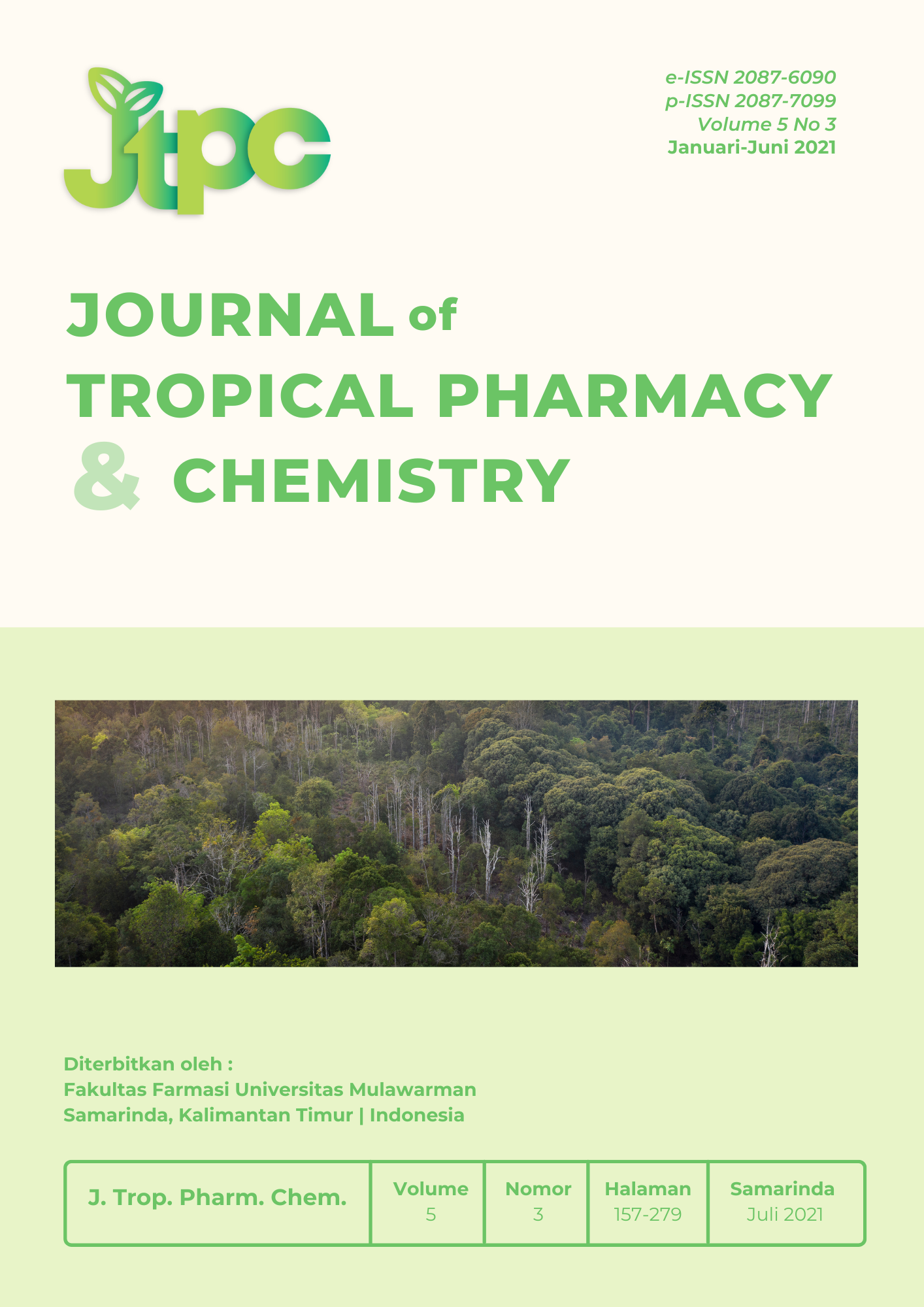Leaf Extract Microencapsulation of Stevia rebaudiana Bert Using Inulin-Chitosan as Anti-Diabetes Diet
DOI:
https://doi.org/10.30872/j.trop.pharm.chem.v5i3.203Keywords:
stevia leaf extract, microencapsulation, anti-diabetesAbstract
Diabetes mellitus is a collection of symptoms that arise in someone who has increased blood glucose levels. The Stevia plant (Stevia rebaudiana Bert) contains a compound of diterpene glycosides as steviosida and rebaudiosida A. Purified extract of steviosida and rebaudiosida A is widely used as a sweetener for low calorie food and beverage products or as a sugar substitute for diabetics and has the effect of lowering blood sugar levels. This study aims to determine the antidiabetic effect of microencapsulated preparations of Stevia leaf extract (Stevia rebaudiana) with a combination of inulin chitosan encapsulation. Antidiabetic mellitus test was carried out in vivo using test animals of male white rats of Wistar strain. The inducing compound that can cause the condition of diabetes mellitus test animals is Aloxan with a dose of 150 mg / kg Body weight of rats. given intraperitoneally for one day, then the mice were allowed to stand for 3 days to reach a state of diabetes mellitus. Blood glucose levels of test animals were measured on days 1 (initial), 5 (induction) and 12 (treatment) to determine the initial blood glucose levels, after induction of alloxan and after administration of test compounds both CMC Na 0.5% , glibenclamide, and preparations microencapsulation of Stevia leaf extract at a dose of 100; 300; and 700 mg / kg body weight. The results were obtained after 7 days of treatment, it was seen that blood glucose levels in the CMC group remained high, while the Glibenclamid administration group, and the three dosages of microencapsulation preparations of Stevia leaf extract could reduce blood glucose levels. This can be seen from the statistical test that there is a significant difference (p <0.05) between the CMC group and the Glibenclamide group, and microencapsulation preparations of Stevia leaf extract. Microencapsulation preparations of Stevia leaf extract can reduce blood glucose levels with an effective dose of 100 mg / kg body weight.
Downloads
References
[1] Filho, J.M.B., Vasconcelos, T.H.C., Alencor, A.A., Batista, L.M., Oliveria, R.A.G., Gudes, D.N., et.,al, 2005, Plants and their Constituens from South, Central, and North America with Hypoglycemic Activity, Brazilia journal of Pharmacognosy, 15(4) : 392-413.
[2] El- Soud , N.H.A., Khalil, M.Y., Hussein, J.S., Oraby, F.S.H., & Farrag, A.R.H., 2007, Antidiabetic Effects of Fenugreek Alkaloid Extract in Streptozotocin Induced Hyperglycemic Rats, Journal of Applied Sciences Research, 3 (10) : 1073-1083
[3]. Dheer R. & Bhatnagar P., 2010, A study of the Antidiabetic Activity of Barleria prionitis Linn, Indian Journal of Pharmacology, Vol 42 (2): 70-73
[4] Pérez ,Y.Y., Jiménez-Ferrer, E. and Zamilpa, A. 2007. Effect of a polyphenol-rich extract from Aloe vera gel on experimentally induced insulin resistance in mice. American Journal of Clinical Medicine 35: 1037-1046
[5]. Gardana, C., Simonetti, P., Canzi, E., Zanchi, R. & Pieta, P. (2003) Metabolism od stevioside and rebaudioside A from Stevia rebaudiana extracts by human microflora. J. Agri. Food Chem., 51, 6618–6622
[6] Bondarev, N., O. Reshetnyak, and A. Nosov. 2001. Peculiarities of diterpenoidsteviol glycoside production in in vitro cultures of Stevia rebaudiana Bertoni. Plant Sci. 161: 155-163
[7] Fu, L., B. T. Xu, R. Y. Gan, Y. Zhang, X. R. Xu, E. Q. Xia, and H. B. Li. 2011. Total Phenolic Contents and Antioksidan Capacities of 58 Herbal and Tea Infusions, International Journal of Molecular Sciences 12: 2112-2124.
[8] Chatsudthipong, Varanuj, and Chatchai, 2009. Steviosida and Related Compounds: Therapeutics Benefits Beyond Sweetness. ELSEVIER Journal of Pharmacology and Therapeutics 121, pp. 41 – 54
[9] Zhao, Chang-Ying and Zhang, Guan H. Review on microencapsulated phase change materials (MEPCMs): fabrication, characterization and applications. Renewable and Sustainable Energy Reviews.2011;15(8):3813-32
[10] Hinrichs WL, Mancenido FA, Sanders NN, Braeckmans K, De Smedt SC, Demeester J, et al. The choice of a suitable oligosaccharide to prevent aggregation of PEGylated nanoparticles during freeze thawing and freeze drying. International Journal of Pharmaceutical. 2006;311(1-2):237-44
[11] Hanley AJG, Stern MP, Williams K, Haffner SM: Homeostasis model assessment of insulin resistance in relation to the incidence of cardiovascular disease. Diabetes Care. 2002, 25: 1177-1184
[12] Watkins D, Cooperstein SJ, Lazarow A. 2008. Effect of alloxan on permeability of pancreatic islet tissue in vitro. American Journal of Physiology
[13] Filipponi P, Gregorio F, Cristallini S, Ferrandina C, Nicoletti I, Santeusanio F. 2008. Selective impairment of pancreatic A cell suppreession by glucose during acute alloxan – induced insulinopenia: in vitro study on isolated perfused rat pancreas. Endocrinology 119
[14] Adamiec, J., and Marciniak, E. 2004. Microencapsulation of Oil/Matrix/Water System During Spray Drying Process. Proceedings of the 14th International Drying Symposium.Vol C:2043-2050
[15] Hossain MS, Alam MS, Asadujjaman M, Islam MM, Rahman MA, Islam MA and Islam A. Antihyperglycemic and antihyperlipidemic effects of different fractions of Stevia rebaudiana leaves in alloxan induced diabetic rats. Intern J PharmaSci Res 2011; 2[7]: 1722-1729.
[16] Shibata H, Sawa Y, Oka T, Sonoke S, Kim KK, Yoshioka M. Steviol and steviol glycoside. Glucosyltransferase activities in S. rebaudianaBertoni.Purification and partial characterization. Arch BiochemBiophys 1995;321:390-6.
[17] Chen J, Jeppesen PB, Nordentoft I, Hermansen K. Stevioside improves pancreatic? cell function during glucotoxicity via regulation of acetyl-CoA carboxylase. Am J PhysiolEndocrinolMetab 2007;292:1906-16




